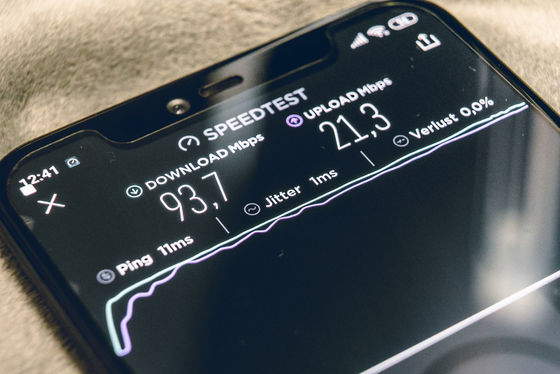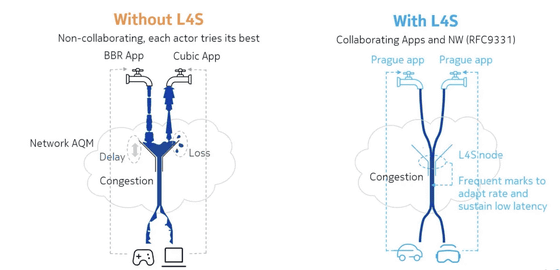Apple, Google, NVIDIA, Valve and others are promoting the new technology 'L4S' that can dramatically speed up the Internet, but what kind of technology is it?

L4S is a new Internet standard that almost completely eliminates 'delay' in Internet communications and has the potential to completely overturn the way we think about Internet communications. Supporters of L4S include major technology companies such as Apple, Google, NVIDIA, and Valve.
Apple, Google, and Comcast's plans for L4S could fix internet lag - The Verge

Internet speeds are getting faster every day, but websites may take a long time to load, high-resolution videos require buffering , or video playback may be interrupted. This has not changed since ancient times. The main cause of this problem is 'latency' (ping).
A plan that can almost completely eliminate this delay is ``L4S'' promoted by Apple, Google, Comcast, Charter, NVIDIA, Valve, Nokia, Ericsson, Deutsche Telekom, the parent company of T-Mobile, and others. L4S is touted as a new internet standard that can significantly reduce loading times for web pages and streaming, and reduce glitches in video calls. Furthermore, it is believed that L4S may even change the way we think about Internet speed and allow developers to create applications that are not possible on the current Internet.

The Internet is a vast network of interconnected routers, switches, and fibers that connect devices to servers elsewhere. If there is a bottleneck somewhere along the route, your surfing experience will suffer. Potential bottlenecks include ``the server hosting the video has limited upload capacity'' and ``a critical part of the Internet infrastructure is down.'' , varies.
But the real complication is that the minimum capacity of the communication speed determines the limits of what is possible. For example, even if the upper limit of Internet communication speed is '8Gbps', if the speed limit of the router you are using is '10Mbps', the upper limit of the data that can be handled will be limited to 10Mbps. Additional delays will be added to this. For example, if there is a delay of 20 milliseconds on the computer side and 50 milliseconds on the router side, you will need to wait at least 70 milliseconds to play a video or display a web page.
In recent years, network engineers and researchers have expressed concern that traffic management systems meant to keep network equipment from becoming overloaded are causing slowdowns, a problem known as

To understand what buffer bloat actually is, we first need to understand what a buffer is. Each part of the network (switches, routers, modems, etc.) has its own limits on the amount of data it can handle. However, because the devices on the network and the amount of traffic they must handle are constantly changing, no computer actually knows how much data to send at any one time.
To figure that out, you usually need to send data at a constant rate. Data exchanged over the Internet is treated as
To accommodate this, network equipment is equipped with buffers . When a device receives a large number of packets at once, it can temporarily store the packets and queue them for transmission. This allows the system to process large amounts of data and smooth out potentially problematic bursts of traffic, but at the cost of 'delay.'
A problem with the existing Internet is that this buffer is very large. Services like YouTube and Netflix have buffers on the device, so the delay may not be as noticeable. However, when using game streaming services such as GeForce NOW, the delay caused by buffers becomes a big problem.

If you measure the time it takes to download a certain song using existing Internet communication, it will take 0.72 seconds for a network with a communication speed of 100Mbps, and 0.288 seconds for a network with a communication speed of 250Mbps. In this case, the difference in throughput affects the download time by less than half, and most of the download time is due to delays across the network. This is the reason why the time it takes to actually download data does not change much even if you use a faster Internet communication line.
L4S, a new internet standard promoted by several major IT companies, stands for 'Low Latency, Low Loss, Scalable Throughput,' meaning that packets wait unnecessarily on the network. The aim is to spend as little time as possible. Aimed at shortening the delay feedback loop, L4S initiates some processing (usually reducing the amount of data sent) to resolve the problem when congestion occurs.
In order to maintain a sufficient amount of data throughput without adding delays that increase the time it takes for data transfer, L4S requires packets to be marked with 'whether congestion occurs while traveling from one device to another'. An indicator will be added. If the data continues to flow, nothing will happen, and if it exceeds the specified time, it will be recorded as a delay. When congestion is detected, the device prevents the congestion from worsening while keeping the data flow as fast as possible, making it possible to bring the delay as close to zero as possible.

Greg White, an engineer at CableLabs, a research and development company that helped develop the L4S standard, says L4S is ``very necessary'' in terms of reducing delays on the Internet. 'Buffering delays typically range from hundreds of milliseconds to even thousands of milliseconds,' White said. However, with L4S, it is possible to reduce that to single-digit milliseconds.'
In addition, considering that it took more than 10 years to introduce IPv6 , overseas media The Verge points out that it will still take a long time until L4S can actually be used. However, about 20 network companies, including Comcast, Charter, and Virgin Media, support L4S, and several Internet service providers (ISPs) have also demonstrated how L4S works in both hardware and software. It has been announced that an experiment is being conducted to test this. Apple has also launched beta support for L4S in iOS 16 and macOS Ventura.
Related Posts:
in Web Service, Posted by logu_ii







